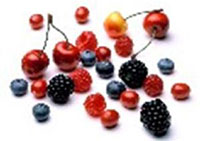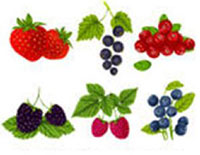Enrich Your Health with Berries!
By: Gisele Jefferson, Family & Consumer Science Extension Agent, Golden Plains Area

If you could take a pill that helped you feel full, prevent disease and lose weight, you would most likely take it. What if it tasted sweet and fruity? Would that make it easier to say yes? Well, you don’t have to see a doctor to get some of this good medicine. Just go to your local grocery store or farmers’ market and load up on a wide selection of fresh or frozen berries. Berries are special sweet little fruits packed full of naturally occurring nutrients that help protect our health in several ways.
Research studies show that eating berries can keep you mentally sharp. In a large study of over 16,000 older women, those who ate about two servings of strawberries and one serving of blueberries per week showed less mental decline over time than their peers who did not eat berries. Nutrients from the berries help the learning and memory parts of the brain. Other studies are trying to learn how berries may prevent Alzheimer’s and Parkinson’s diseases.
Berries can help manage diabetes and weight control. Berries are high in fiber, which helps slow the digestion process and reduce the blood glucose spike following a meal or snack. Their high fiber also helps us feel full and go longer between meals.
Berries can also help with disease prevention. People who eat berries regularly benefit from the vitamins and other nutrients that reduce inflammation and high blood pressure, and reduce the risk of heart attacks. Berries may also help prevent and treat urinary tract infections, and reduce the risk of developing several types of cancer.
Explore Healthy Berries

- Blackberries – great source of fiber – one cup has about 7 grams of fiber. (The recommended daily intake of fiber is 25 to 35 grams.) They are rich in vitamin C, and contain some iron, calcium, and vitamin A.
- Blueberries – have high levels of compounds that widen arteries and help blood flow smoothly. They are rich in antioxidants, good source of fiber and vitamin C.
- Strawberries – are an excellent source of vitamin C, and folate, which is a nutrient that is good for your heart by widening the arteries and help prevent plaque buildup.
- Raspberries – rich in heart healthy fiber with 4 grams in one-half cup berries. They are a rich source of vitamin C, manganese, and polyphenols.
- Acai berries – very high in antioxidants, and a good source of fiber. They are tart in flavor and good in smoothies, oatmeal and yogurt.
- Cranberries – tart little berries are popular around the holidays; but should be eaten year-round. They help increase HDL – the good cholesterol, and help prevent urinary tract infections.
Berries are very seasonal, with a shorter time that they are available as fresh fruit in our markets. They also cost more per pound than many other fruits, so you don’t want to waste any. Watch for sales on berries to get the best price. Enjoy fresh berries when they are at their peak of ripeness. Wash berries in cold running water just prior to eating. Put them into a fruit salad, or add them to a fresh green salad.
Extra berries can easily be frozen to use later. Wash the ripe berries; and pat them dry with paper towels. Spread them on a sheet of waxed paper or parchment paper in a baking sheet. Place the pan of berries in the freezer for a couple hours until the berries are frozen. Place the frozen berries into freezer bags, remove as much air as you can from the bag, and label and date them before placing them back in the freezer.
With overripe berries (but not moldy) puree them in a blender. You can add a little sweetener or yogurt. Then freeze the mixture in ice cube trays or in freezer bags, to be used later in smoothies or drizzle over a dessert.
Let’s Talk
Berries are fun to eat and packed with powerful nutrition! Help children explore the many shapes, colors, sizes, smells and tastes of berries, by having a taste test of at least two kinds of berries. Explain that berries help our bodies grow strong and healthy. Try to grow some berries in your own backyard garden! Ask “How many berries can you name?” Some berries grow wild. “Can you name any wild berries?” Talk with your grandparents or older neighbors and ask them about wild berries. They probably have eaten Elderberry Jam or Chokecherry Jelly.
| What Do You Think? |
| Please click here to take a short survey of the Family Matters NewsletterIf you receive a printed copy of this newsletter, a printed copy of the evaluation should be attached.If not, please call Sheila Gains at 303-730-1920 to request a return postage paid printed copy of the evaluation. Thank you! |
Recipe for Health:
Coulis

One of the easiest things to do with ripe berries is to prepare a sauce called coulis. A fruit coulis is nothing more than a fruit puree that has been sweetened. A coulis is beautiful in color, wonderful in flavor and contains little or no fat or sodium. Tips on making coulis:
- Puree berries with cantaloupe or peaches.
- Sweeten with just a little sugar, honey, syrup or sugar substitute for added sweetness.
- To make it creamy, puree a small amount of banana with the berries.
- Use coulis as a sauce for fresh fruit salad, sorbets, or fruit ice; or as a dipping sauce, or add it to a smoothie. Drizzle it on a small slice of angel food cake, ice cream, custard/flan or cheesecake for dessert.
If you haven’t let us know what you think about the Family Matters Newsletter yet, please click on the link below to take a short survey. . If you would like a printed copy of the survey sent to you please call Sheila Gains at 303-730-1920. Thank you!
http://studentvoice.com/colostate/familymattersnewsletteren2015.





